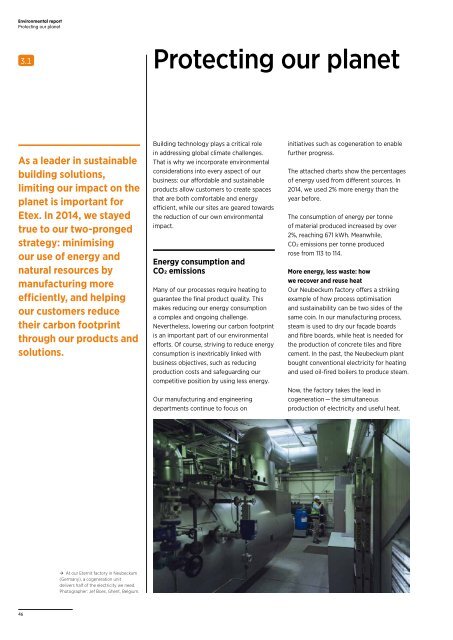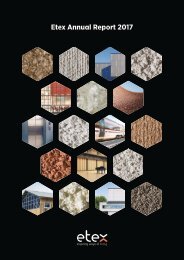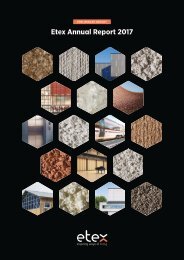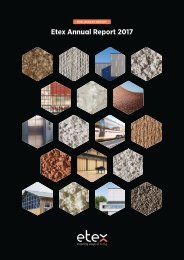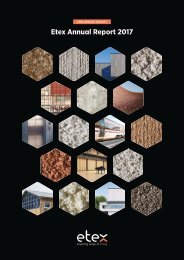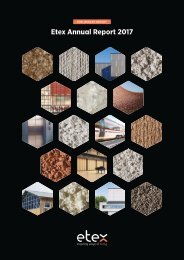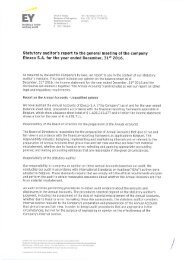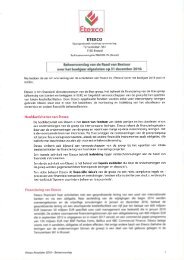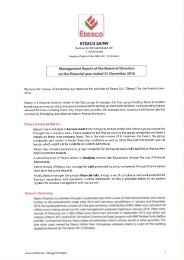Annual Report 2014
This is the 2014 annual report of Etex Group
This is the 2014 annual report of Etex Group
Create successful ePaper yourself
Turn your PDF publications into a flip-book with our unique Google optimized e-Paper software.
Environmental report<br />
Protecting our planet<br />
3.1<br />
Protecting our planet<br />
As a leader in sustainable<br />
building solutions,<br />
limiting our impact on the<br />
planet is important for<br />
Etex. In <strong>2014</strong>, we stayed<br />
true to our two-pronged<br />
strategy: minimising<br />
our use of energy and<br />
natural resources by<br />
manufacturing more<br />
efficiently, and helping<br />
our customers reduce<br />
their carbon footprint<br />
through our products and<br />
solutions.<br />
Building technology plays a critical role<br />
in addressing global climate challenges.<br />
That is why we incorporate environmental<br />
considerations into every aspect of our<br />
business: our affordable and sustainable<br />
products allow customers to create spaces<br />
that are both comfortable and energy<br />
efficient, while our sites are geared towards<br />
the reduction of our own environmental<br />
impact.<br />
Energy consumption and<br />
CO2 emissions<br />
Many of our processes require heating to<br />
guarantee the final product quality. This<br />
makes reducing our energy consumption<br />
a complex and ongoing challenge.<br />
Nevertheless, lowering our carbon footprint<br />
is an important part of our environmental<br />
efforts. Of course, striving to reduce energy<br />
consumption is inextricably linked with<br />
business objectives, such as reducing<br />
production costs and safeguarding our<br />
competitive position by using less energy.<br />
Our manufacturing and engineering<br />
departments continue to focus on<br />
initiatives such as cogeneration to enable<br />
further progress.<br />
The attached charts show the percentages<br />
of energy used from different sources. In<br />
<strong>2014</strong>, we used 2% more energy than the<br />
year before.<br />
The consumption of energy per tonne<br />
of material produced increased by over<br />
2%, reaching 671 kWh. Meanwhile,<br />
CO2 emissions per tonne produced<br />
rose from 113 to 114.<br />
More energy, less waste: how<br />
we recover and reuse heat<br />
Our Neubeckum factory offers a striking<br />
example of how process optimisation<br />
and sustainability can be two sides of the<br />
same coin. In our manufacturing process,<br />
steam is used to dry our façade boards<br />
and fibre boards, while heat is needed for<br />
the production of concrete tiles and fibre<br />
cement. In the past, the Neubeckum plant<br />
bought conventional electricity for heating<br />
and used oil-fired boilers to produce steam.<br />
Now, the factory takes the lead in<br />
cogeneration — the simultaneous<br />
production of electricity and useful heat.<br />
ppAt our Eternit factory in Neubeckum<br />
(Germany), a cogeneration unit<br />
delivers half of the electricity we need.<br />
Photographer: Jef Boes, Ghent, Belgium.<br />
46


